 |
 |
 |
| |
SLAM-C Study: Maintenance Therapy in Coinfected
|
| |
| |
(SLAM-C) Sustained Long-term Antiviral Maintenance with Pegylated Interferon in HCV/HIV-co-infected Patients: Early Viral Response and Effect on Fibrosis in Treated and Control Subjects
CROI Feb 3-6, 2008, Boston
Kenneth Sherman*1, J Andersen2, A Butt3, Z Goodman4, T Umbleja2, B Alston6, M Koziel5, M Peters7, M Sulkowski8, R Chung9, and ACTG A5178 Study Team
1Univ of Cincinnati, OH, US; 2Harvard Sch of Publ Hlth, Boston, MA, US; 3Univ of Pittsburgh, PA, US; 4Armed Forces Inst of Pathology, Washington, DC, US; 5Beth Israel Deaconess Med Ctr, Boston, MA, US; 6NIAID, NIH, Bethesda, MD, US; 7Univ of California, San Francisco, US; 8Johns Hopkins Univ, Baltimore, MD, US; and 9Massachusetts Gen Hosp, Boston, US
From Jules: so now 2 studies have been recently presented HALT-C in monoinfection at AASLD in Nov 2007 and this one SLAM-C in coinfection on the question of whether maintenance therapy of peginterferon is beneficial. Both studies used Pegasys. At AASLD study investigators reported in an oral presentation not finding a benefit for maintenance therapy. Further detailed analysis is forthcoming. In the SLAM-C neither the patient group receiving Pegasys maintenance therapy nor the observation control group not receiving Pegasys maintenance therapy displayed firbosis progression so it is difficult to see if Pegasys did slow progression. Given these 2 study results I remain unconvinced that maintenance therapy is not effective in slowing fibrosis progression in the face of many previous studies, although many or all were not randomized and prospective, finding that maintenance interferon therapy can slow HCV progression. But in the face of these findings from SLAM-C & HALT-C care providers may feel it appropriate to not recommend nor to utilize maintenance therapy at least for now. More detailed analyses from HALT-C may identify certain patient groups for whom benefit is observed and perhaps a better understanding and further discussion of these studies will shed more light on understanding these confusing study results. But for now many clinicians may decide not to use maintenance therapy, or to limit its use for certain circumstances. During the Q&A after Sherman's talk he said there was worsening of necroinflammatory markers in the control/observation group that was statistically significant but there was no change at all in the necroinflammatory markers in the maintenance therapy group. Sherman was asked if results may have been different if a lower Pegasys dose was used but he didn't appear to have an answer although he said it was a good question.
ABSTRACT
Background: Persons co-infected with hepatitis C virus (HCV)/HIV are reported to have more rapid liver disease progression than those with HCV alone. We hypothesized that maintenance therapy with pegylated interferon could reduce fibrosis progression among non-responders.
Methods: HCV/HIV-co-infected subjects, naive/refractory to HCV treatment, were treated with pegylated interferon-α-2a 180 μg/week + weight-based ribavirin 1000 to 1200 mg once daily for 12 to 18 weeks. Early virologic response was defined as HCV RNA undetectable (<600 IU) or 2-log drop at week 12. Non-early virologic responses underwent liver biopsy and were randomized to receive pegylated interferon 180 μg alone or observation for 72 weeks. Liver biopsy obtained at start and end of therapy were blinded and read by a single pathologist; 134 subjects required to determine whether pegylated interferon maintenance produced 0.18 unit/year reduction in the rate of Metavir fibrosis progression.
Results: We enrolled 330 subjects, of whom 329 initiated pegylated interferon/weight-based ribavirin. Median age was 48 years; 83% male; 43% white, 37% black, non-Hispanic and 15% Hispanic; median HCV viral load was 6.6 log IU; CD4+ was 498 cells/mm3; 32% were interferon experienced; 74% had HIV RNA <50 copies/mL at entry. Early virologic response was observed in 55.6% (95%CI 50 to 61%; intent-to-treat analysis) of subjects; 42% achieved undetectable HCV. A strong association identified between early virologic response and gender (male >female), race (white >Hispanic >black), fibrosis (non-cirrhotic >cirrhotic), aspartate aminotransferase (AST) (lower >higher), absolute neutrophil count and hemoglobin (both higher >lower). We randomized 86 non-early virologic responders to pegylated interferon vs observation, of whom 72% were male; 71% non-white; median age was 49 years; median CD4 was 392 cells/mm3; 77% had HIV <50 copies/mL; median HCV RNA was 545,500 IU. Median entry Metavir score was 2; 28% had advanced fibrosis (F3, F4). A Safety Monitoring Committee determined that the maintenance hypotheses could not be tested due to the lack of progression with observation. Prior to early closure, 62 entries completed 72 weeks. Of the 62, 45 have paired liver biopsy (24 pegylated interferon, 21 observation). median fibrosis change was 0.0 units/year (Q1,Q3: Ğ0.69, 0.61) with observation compared to the expected rate of 0.18 units/year. Pegylated interferon-treated subjects also had a median fibrosis score change of 0.0 (Q1,Q3: 0.0, 0.69)
Conclusions: Pegylated interferon/weight-based ribavirin achieved higher levels of early virologic response than observed in ACTG 5071 which used lower doses of ribavirin (55.6% vs. 41%). Race appears to be an important independent factor in early virologic response. In contrast to recent reports, this randomized controlled trial failed to identify significant change in hepatic fibrosis among untreated non-early virologic responses over 72 weeks.
Sherman suggested that perhaps the 12-week lead-in period where patients received Peg/RBV before being assigned to maintenance therapy may have provided at least a transient stop in fibrosis progression, and he concludes acknowledging modest sample size, the failure to observe improvement in histology in this study does not support use of maintenance therapy.
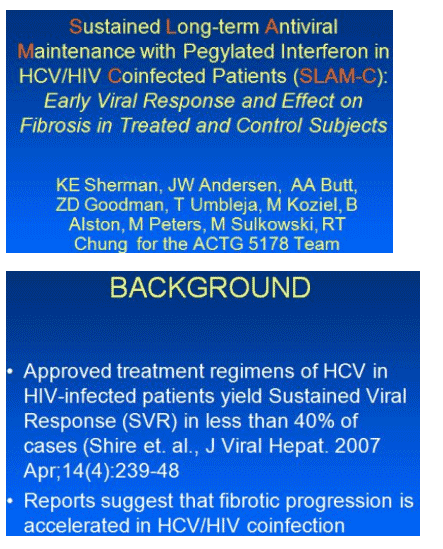
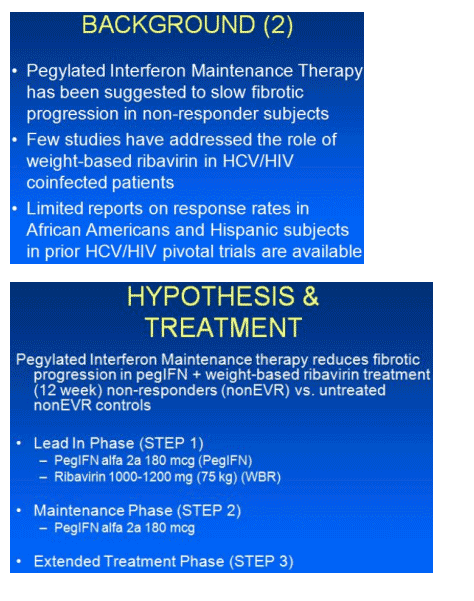
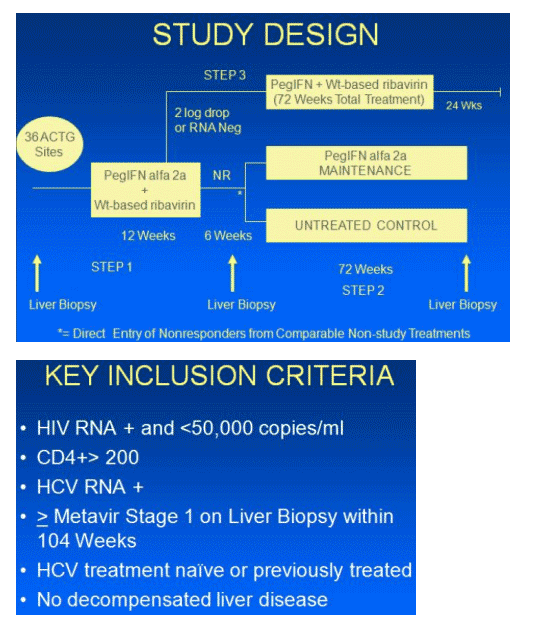
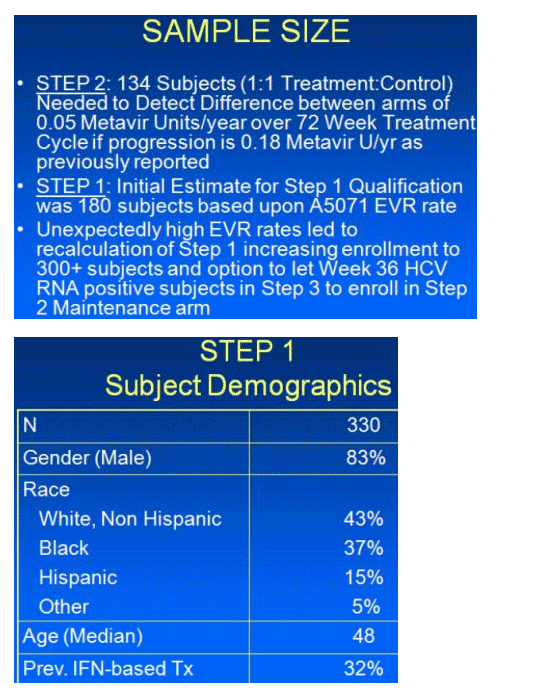
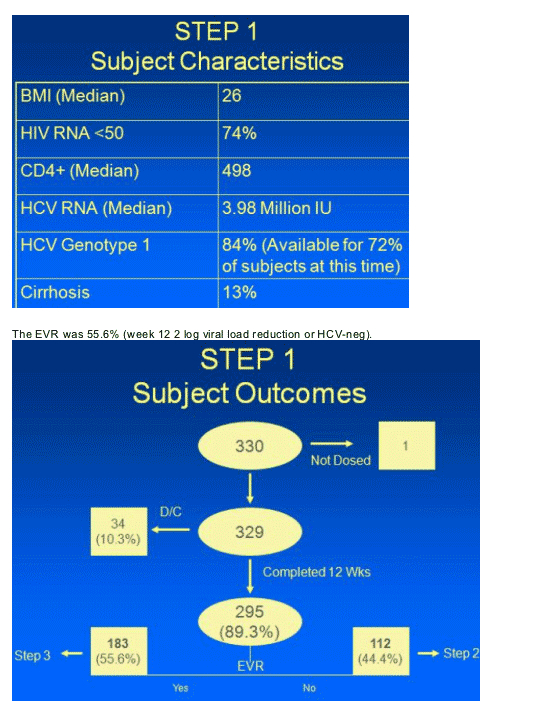
There were EVR differences ("3 prominent findings", Sherman) by genotype, race, and gender but none of these results are unexpected: 90% genotype 2/3 achieved EVR; 65% whites, 42% Blacks, 56% Hispanics achieved EVR; 58% men, 42% women achieved EVR.
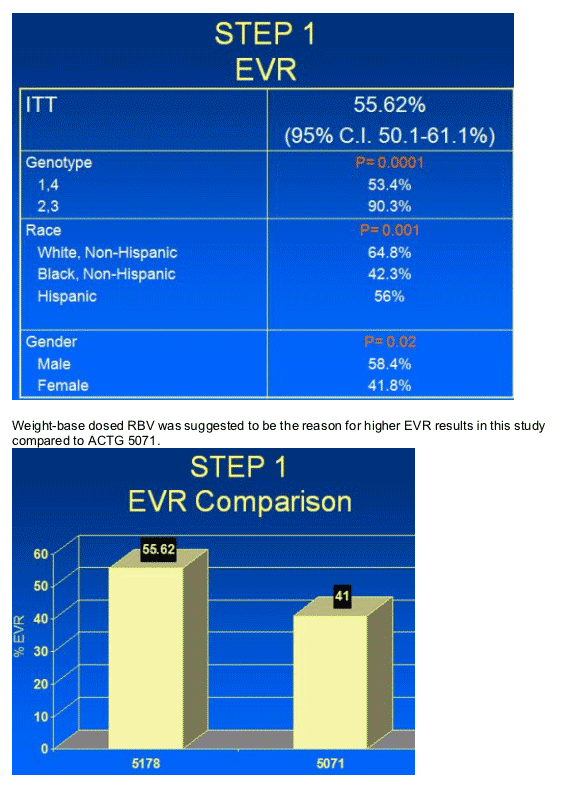
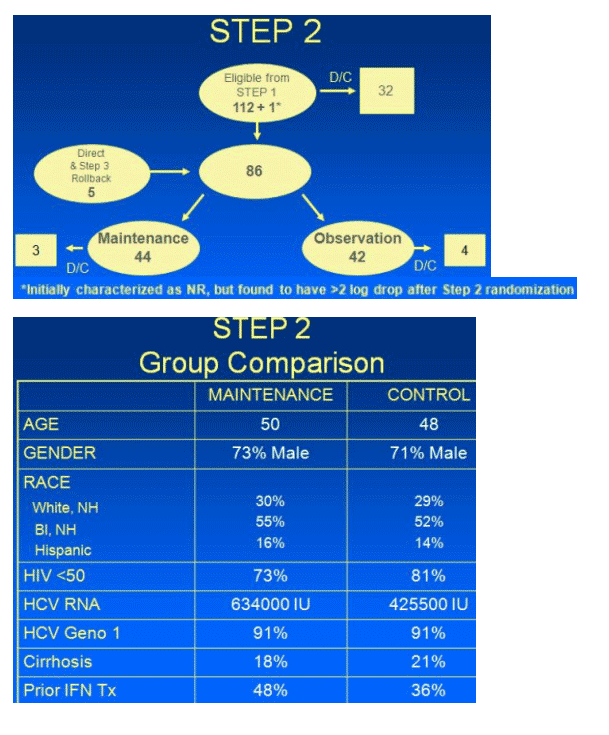
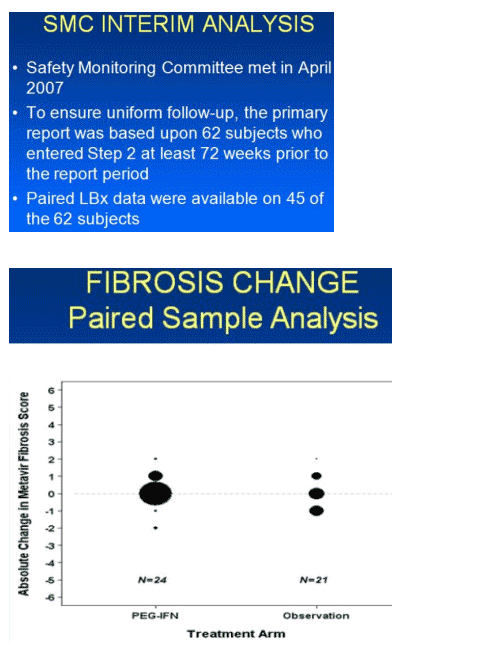

|
| |
|
 |
 |
|
|